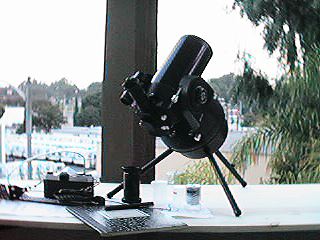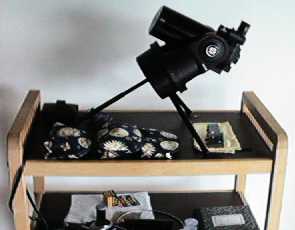BUYER/NEW USER TIPS
Last updated: 23 August 1997
BUYER/NEW USER TIPS |
When first unpacking the ETX and putting it together, you have to insert the Finderscope into its holder and align it. This is a major pain, considering its closeness to the eyepiece holder and main tube. There are six alignment screws, two of which are near the left mounting attachment and are very difficult to turn. Getting an accurate alignment took me many minutes and resulted in sore fingertips! The next major difficulty was removing the bottom baseplate to insert the three AA batteries for the drive. After removing the three screws, the plate would not come off. After several minutes of frustration, I finally discovered that I needed better leverage to pull it off. So I inserted the latitude tripod leg in its normal position and then used the leg as a handle to pull the plate off. It worked. Inserting the batteries was a tight push but nothing compared to removing them again. I can imagine the fun I'm going to have at a dark location doing this! I think that Meade needs to engineer a better way to replace the batteries. An access port or sliding drawer would have been more convenient. Operationally, the only minor difficulty I have experienced is with the drive motor. When first turned on, it can take up to a minute to engage fully. Once engaged, it did not always re-engage right away after positioning the telescope on a new object. Once it did engage, tracking was adequate at low power. Higher powers were limited by my not taking the time (yet) to do a polar alignment. My current observing location makes polar alignments difficult. Finally, my first ETX had a piece of debris on the outside of the corrector lens. It would not brush off and even a light cleaning would not remove it. Fortunately, the local "The Nature Company" where I purchased the ETX was willing to exchange it as soon as they received another shipment (they can't keep them in stock). They offered to try to clean the lens and used a strong cleaner. It took off the debris (and probably some of the coating) but also left a "shadow" of the debris. The replacement ETX arrived in a couple of weeks and showed no obvious flaws.
 On the very positive side of the ledger, the ETX is a beautiful telescope. Its small size makes it very convenient to set up at a moment's notice for an observing session. Since, prior to my move, I had only a limited area to set up, I purchased a large piece of wood to use as a table for the telescope and accessories during a session. This setup worked great. I purchased some Meade accessories with the telescope. It comes with a 26mm (48x) eyepiece; I added a 9.7mm eyepiece (128x), a 2x Barlow lens, a 45-degree erecting prism, and a T-Adapter for a camera. The telescope and accessories are of high quality. Optically, the telescope has already provided some amazing views, even through the brightly lit and hazy Los Angeles sky. Views of the Moon, Jupiter, Saturn, and Venus are very crisp and bright, even at the higher magnifications. Stars and Jupiter's moons are nice points of light. I can't wait to take it to some really dark skies.
On the very positive side of the ledger, the ETX is a beautiful telescope. Its small size makes it very convenient to set up at a moment's notice for an observing session. Since, prior to my move, I had only a limited area to set up, I purchased a large piece of wood to use as a table for the telescope and accessories during a session. This setup worked great. I purchased some Meade accessories with the telescope. It comes with a 26mm (48x) eyepiece; I added a 9.7mm eyepiece (128x), a 2x Barlow lens, a 45-degree erecting prism, and a T-Adapter for a camera. The telescope and accessories are of high quality. Optically, the telescope has already provided some amazing views, even through the brightly lit and hazy Los Angeles sky. Views of the Moon, Jupiter, Saturn, and Venus are very crisp and bright, even at the higher magnifications. Stars and Jupiter's moons are nice points of light. I can't wait to take it to some really dark skies.
For the price of $495 (the price in September 1996; it has since increased to $595), the ETX is a great telescope if you want portability, ease of setup, and some basic astronomical viewing and photography. I can also recommend The Nature Company as a Meade dealer.
 My previous location was not ideal for observing since it was nearly at sea level with lots of heat sources around disturbing the air. My new location, about 1190' elevation, has steady dark skies that really demonstrate just how great optically the ETX is. Dim stars were crisp pinpoints of light, bright stars had a nice Airy disk with several interference rings visible. Now if I could just see Polaris to get a polar alignment but there is a tree in the way!
My previous location was not ideal for observing since it was nearly at sea level with lots of heat sources around disturbing the air. My new location, about 1190' elevation, has steady dark skies that really demonstrate just how great optically the ETX is. Dim stars were crisp pinpoints of light, bright stars had a nice Airy disk with several interference rings visible. Now if I could just see Polaris to get a polar alignment but there is a tree in the way!
I am now using a very sturdy microwave table on wheels for holding the ETX. It works great. I just wheel the scope out the door onto the patio, line up the compass (adjusted for the magnetic variation; still working the polar alignment), remove my ETX cover, and viola, I'm ready to observe.
On the night of 22-23 August 1997 I spent several hours observing and photographing Jupiter and Saturn. You can see the astrophotos in my Planet Gallery. Seeing was incredibly steady. Using the number 82A Light Blue color filter, cloud bands on Jupiter and Saturn really stood out. And Cassini's Division in Saturn's Rings was clearly visible as was the ring shadow on Saturn's disk. The optics of the ETX continue to impress me.
Return to the top of this page.
Go back to the Buyer/New User Tips page.
Go back to the ETX Home Page.